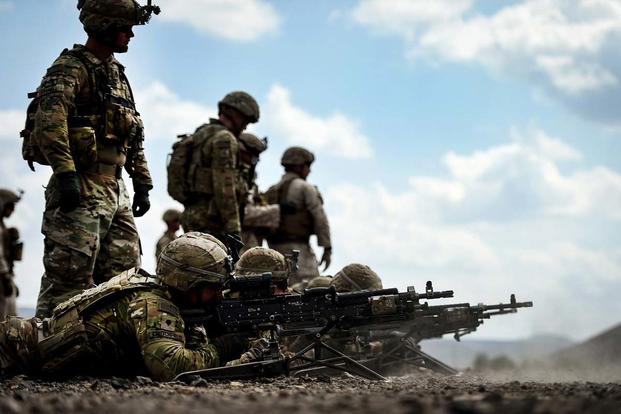House and Senate negotiators have backed a 2.4 percent military pay raise for fiscal 2018, topping President Donald Trump's recommendation of 2.1 percent.
In a background briefing Wednesday, House staffers said the proposed Fiscal 2018 National Defense Authorization Act would also boost end strength by more than 20,000 troops and funding for a wide variety of weapon systems, from aircraft to ships to ground vehicles.
The differences between the congressional 2.4 percent pay raise proposal and the administration's 2.1 percent recommendation will have to be worked out before Dec. 8, when a Continuing Resolution to keep the government running at 2017 levels expires.
House Armed Services Committee Chairman Rep. Mac Thornberry, R-Texas, has argued that the 2.4 percent pay raise is in line with "statutory requirements" under federal law, which have often been ignored by presidents of both parties.
Related content:
- Dramatic Tricare Drug Cost Hike Advances in Congress
- Space Corps Crashes to Earth in Negotiated Defense Bill
- Lawmakers Back $400 Million for Possible A-10 Successor
The proposed pay raise, which would roughly match recent wage growth in the private sector, would be the largest for the military since 2010. Last year, then-President Barack Obama proposed a 1.6 percent pay raise for the military but Congress boosted that to 2.1 percent.
Thornberry and Sens. Joni Ernst, R-Iowa, and Elizabeth Warren, D-Massachusetts, have cited the federal mandate that pay raises should be tied to the Employment Cost Index prepared by the Bureau of Labor Statistics "unless the president cites economic concerns or a national emergency."
BAH Preserved
Meanwhile, a Senate proposal that would have reduced the amount of cash dual military couples with children receive through the Basic Allowance for Housing (BAH) was scrapped.
Currently, married military members each collect their own housing allowance. If the couple has kids, one of them collects BAH at the "with dependents" rate, while the other collects it at the "without dependents" rate.
The Senate proposal sought to knock both couples down to the "without dependents" rate. That would decrease the monthly paycheck of affected couples anywhere from about $100 to as much as $600 or more per month, depending on location and paygrade.
Instead, under the negotiated version of the defense bill, those couples will continue to receive that entitlement under the current system with one spouse receiving the "without dependents" BAH rate, while the higher-ranking spouse receives the "with dependents" rate.
20K More Troops
The proposed total increase of military end strength by 20,300 personnel includes 16,600 for active duty, 1,400 for the National Guard, and 2,300 for the Reserves. The active-duty increase would increase that component's end strength from about 1.34 million to 1.36 million, according to Defense Department figures as of Aug. 31.
The House and Senate end-strength increases included 7,500 active duty, 500 Guard and 500 Reserves for the Army; 4,000 active duty and 1,000 Reserves for the Navy; 4,100 active duty, 900 Guard and 800 Reserves for the Air Force; and 1,000 active duty for the Marine Corps.
At the background briefing, staffers speaking on grounds of anonymity said the overall proposed defense budget for fiscal 2018 would be $699.6 billion. The $699.6 billion includes $65.7 billion for Overseas Contingency Operations (OCO), the so-called "war budget" for operations in Afghanistan, Iraq, Syria and elsewhere.
The proposed budget of $699.6 billion represents a major increase over Trump's request for a base budget of $603 billion and OCO funding of $65 billion.
Hurdles Ahead
However, the agreement worked out by House and Senate conferees faces several major hurdles.
The first is the figure of $549 billion, the current limit for base defense spending under the budget caps of the sequester process. Congress will have to lift the caps to enact a $699.6 budget, which will require 60 votes in the Senate.
The staffers suggested that there is strong bipartisan support for lifting the caps, pointing to the wide margins with which the $699.6 billion proposal was passed -- 344-81 in the House and 89-8 in the Senate.
The proposed budget provides funding for 90 F-35 Joint Strike Fighters -- 20 more than Trump requested, and 24 F/A-18 Super Hornet jet fighters -- 10 more than requested. The budget also calls for three new littoral combat ships -- two more than Trump requested.
The staffers said the proposed budget takes no position on Trump's proposal to exclude transgender people from military service.
Trump had ordered a reinstatement of the long-standing policy that barred transgender individuals from joining the military, and also ordered that transgender individuals currently serving could be subject to discharge. A federal judge last month blocked the Trump administration from proceeding with the plan.
The proposed defense budget approved by the conference committee will now go to a vote on the floors of the House and Senate, with a vote in the lower chamber potentially coming as early as next week. Afterward, Congress will have to hash out methods to pay for the budget while also working against the Continuing Resolution that will expire Dec. 8.
-- Amy Bushatz contributed to this report.
-- Richard Sisk can be reached at Richard.Sisk@Military.com.





























